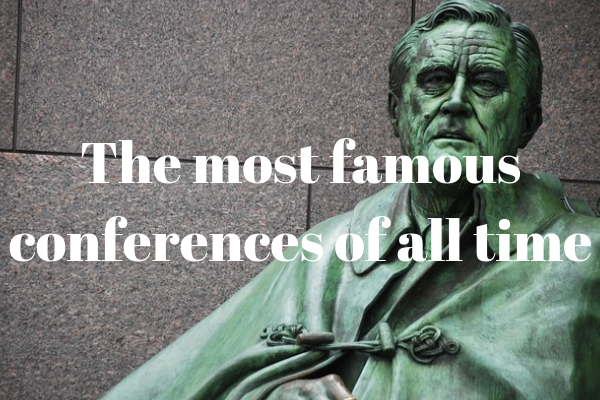
The 5 Most Famous Conferences Ever
Read a summary using the INOMICS AI tool
Conferences have been a force for development and diplomacy on the international stage throughout the twentieth century. Here are five of the most famous conferences which have shaped our modern world.
Download the Conference Monkey Directory - 6 Month Conference List

Yalta Conference, 4th - 11th February 1945, Yalta, Soviet Union
Arguably the most famous conference of all time, the Yalta Conference was the meeting of the heads of the Allied powers following World War II in order to reorganise postwar Germany. Attended by the three heads of state of the Allied powers - President Franklin D. Roosevelt, Prime Minister Winston Churchill and Premier Joseph Stalin – the conference aimed to create a post-war period of peace and stability in Europe. Notably, General Charles de Gaulle of France was not invited to participate in the conference, which was the source of diplomatic troubles for many years afterwards.
The “Big Three” powers, as they were known, were obliged to put aside long-standing political differences in order to create a compromise for how to deal with Germany and post-war Europe in general. In the end, the compromise they reached was that after the unconditional surrender of Nazi Germany, Germany would be divided into four occupied, one each controlled by the powers of the U.S., Britain, France, and the Soviet Union. Germany was to be demilitarised and reparations were demanded in order for Germany to repay the costs of the war to other countries. The long-term implications of the Yalta conference were felt for decades afterwards, and it marked the final stage of the war and the formation of Europe as it stands now.
Potsdam Conference, 17th July – 2nd August 1945, Potsdam, Germany
Following the Yalta Conference, the Potsdam Conference was a further meeting of the heads of state of the Allied powers. The aim of the conference was to arrange the specifics of how Germany would be administered within Europe, in addition to establishing peace treaties and ensuring long-term stability in Europe.
This time the representatives were Communist Party General Secretary Joseph Stalin, Prime Ministers Winston Churchill and Clement Attlee, and President Harry S. Truman. Tensions were rising between the U.S. and British representatives and Stalin due to the Soviet Union's occupation of central and eastern Europe, which Stalin claimed was necessary to protect the Soviet Union from possible future attacks. In addition, President Roosevelt had died a few months earlier in April 1945 and was replaced by his Vice President Harry Truman. Truman had a more antagonistic attitude towards Soviet Communism than Roosevelt had had, and saw the occupation of eastern European states by the Soviet Union as a threat. In addition, British Prime Minister Winston Churchill was replaced by his successor, Clement Atlee, halfway through the conference due to the results of a general election, contributing to the diplomatic complexity. Despite these challenges, the conference was successful in agreeing on practical steps for the administration of Germany going forward.
Vienna Summit, 4th June 1961, Vienna, Austria
At the height of the Cold War, the leaders of the two global superpowers - President John F. Kennedy of the United States and Premier Nikita Khrushchev of the Soviet Union – met to discuss critical issues such as the divided city of Berlin and the failed invasion of Cuba by U.S. forces in the months before the summit. The issue at stake with Berlin was whether the U.S. would allow to Soviet Union to sign a separate peace treaty with Berlin. The large numbers of people who were moving from Soviet-controlled East Berlin into West Berlin meant a drop in population, hence the Soviet interest in establishing an independent peace treaty. The U.S. preferred to keep the situation as it was, with Germany and Berlin itself divided in a way that advantaged them.
In the end, despite the attempts at diplomacy, within a few months of the summit the Berlin Wall had been constructed which divided the city into Communist East and the Allied West, cutting off West Berlin and preventing people from escaping from the East to the West. In addition, the Cuban Missile Crisis of October 1962 brought Soviet-U.S. tensions to a head and almost began a third world war.
Earth Summit, 3rd - 14th June 1992, Rio de Janeiro, Brazil
Hosted by the United Nations, the Rio Conference was a meeting of more than 100 heads of state that was created to foster co-operation between nations on development issues following the Cold War. The particular focus was on sustainable development, with discussion of environmental issues that were only just starting to be understood. The conference is historically important as one of the first major steps towards a unified international approach to challenges such as climate deterioration and limited environmental resources.
The biggest outcome of the conference was the agreement of the Climate Change Convention which aimed to reduce the level of greenhouse gases in the atmosphere, and which eventually lead to the Kyoto Protocol and the Paris Agreement. The conference produced a document called the Rio Declaration on Environment and Development which listed 27 principles that countries should follow for sustainable development, such as that those companies who create pollution should be responsible for paying for the damage it caused.
World Conference on Human Rights, 14th - 25th June 1993, Vienna, Austria
Another important historical conference that happened in the 1990s, the World Conference on Human Rights was the first conference focused on human rights that had been held since the end of the Cold War. The aim of the conference was to reach agreement on the principles of human rights, although extensive agreements made before the conference forbade the discussion of specific human rights abuses that were happening in particular countries at the time. The conference took the question of human rights in the abstract, although in practice much of the discussion at the conference did reference specific examples of human rights abuses at the time.
The conference established the Vienna Declaration and Programme of Action, a declaration on human rights that lead to the establishment of the position of United Nations High Commissioner for Human Rights. The declaration specified human rights as a universal standard and covered topics such as poverty, the right to development in economic terms, the right of individuals to seek asylum, a statement against racism, and protections for oppressed groups such as indigenous peoples, migrant workers, women, and disabled people. In addition, it established rights of children to education, clean water, and basic nutrition. This conference and the declaration that it established formed the basis for the modern conception of international human rights.
Download the Conference Monkey Directory - 6 Month Conference List
Top Blog Posts to Read:
What's the difference between a conference, a seminar, a workshop and a symposium?
8 Benefits of Attending Conferences
What Should Women Wear to Academic Conferences?
What Should Men Wear To Academic Conferences?
A Guide to Asking Good Questions at Conferences
How To Improve Your Public Speaking
-
- Conferencia
- Posted 2 months ago
CALL FOR PAPERS - 18th YOUNG ECONOMISTS’ SEMINAR (YES)
Between 6 Jun and 8 Jun in Dubrovnik, Croacia -
- Conferencia
- Posted 1 week ago
PhD Lausanne Macroeconomics Conference
Between 4 Dec and 5 Dec in Lausanne, Suiza
-
- Conferencia
- Posted 2 days ago
Call for Papers: Fifth International Annual Conference on A New Global Order, Yet Again
Between 13 Nov and 14 Nov in Karachi, Pakistán













